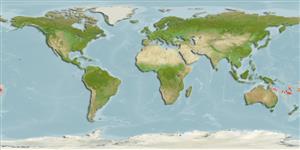>
Perciformes/Serranoidei (Groupers) >
Serranidae (Sea basses: groupers and fairy basslets)
Etymology: Chelidoperca: Greek, chelidon, -onos = swift, as black as a swift + Greek, perke = perch (Ref. 45335).
Environment: milieu / climate zone / depth range / distribution range
पारिस्थितिकी
समुद्री ड़िमरसल; गहराई सीमा ? - 300 m (Ref. 33595). Tropical
Western Pacific: New Caledonia (Chesterfield Islands).
आकार / वज़न / Age
Maturity: Lm ? range ? - ? cm
Max length : 13.0 cm SL पुल्लिंग / अलिंग; (Ref. 33595)
Minimum depth from Ref. 58018.
Life cycle and mating behavior
Maturities | पुनरुत्पत्ति | Spawnings | Egg(s) | Fecundities | लार्वा
Fourmanoir, P., 1982. Trois nouvelles espèces de Serranidae des Philippines et de la Mer du Corail Plectranthias maculatus, Plectranthias barroi, Chelidoperca lecromi. Cybium 6(4):57-64. (Ref. 33595)
IUCN Red List Status (Ref. 130435)
Threat to humans
Harmless
Human uses
साधन
Special reports
Download XML
इंटरनेट स्रोत
Estimates based on models
Preferred temperature (Ref.
123201): 20.3 - 23.7, mean 22.6 °C (based on 6 cells).
Phylogenetic diversity index (Ref.
82804): PD
50 = 0.5010 [Uniqueness, from 0.5 = low to 2.0 = high].
Bayesian length-weight: a=0.00490 (0.00200 - 0.01202), b=3.12 (2.91 - 3.33), in cm total length, based on LWR estimates for this (Sub)family-body shape (Ref.
93245).
Trophic level (Ref.
69278): 3.6 ±0.5 se; based on size and trophs of closest relatives
लौटाव (Ref.
120179): माध्यम, न्यूनतम जनसंख्या दुगनी होने का समय 1.4 - 4.4 वर्ष। (Preliminary K or Fecundity.).
Fishing Vulnerability (Ref.
59153): Low vulnerability (10 of 100).
